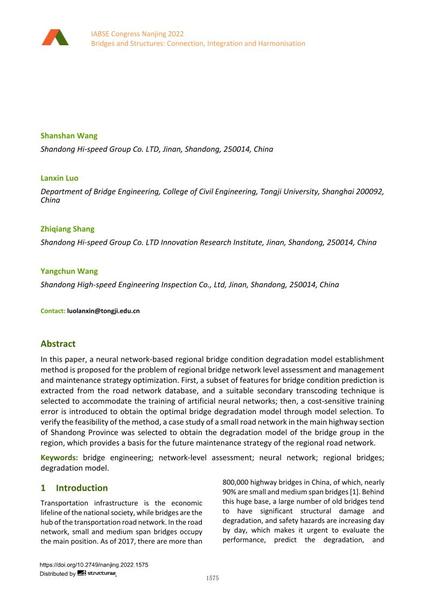Establishment of Regional Bridge Degradation Model for Shandong Province

|
|
|||||||||||
Bibliografische Angaben
| Autor(en): |
Shanshan Wang
(Shandong Hi-speed Group Co. LTD, Jinan, Shandong, 250014, China)
Lanxin Luo (Department of Bridge Engineering, College of Civil Engineering, Tongji University, Shanghai 200092, China) Zhiqiang Shang (Shandong Hi-speed Group Co. LTD Innovation Research Institute, Jinan, Shandong, 250014, China) Yangchun Wang (Shandong High-speed Engineering Inspection Co., Ltd, Jinan, Shandong, 250014, China) |
||||
|---|---|---|---|---|---|
| Medium: | Tagungsbeitrag | ||||
| Sprache(n): | Englisch | ||||
| Tagung: | IABSE Congress: Bridges and Structures: Connection, Integration and Harmonisation, Nanjing, People's Republic of China, 21-23 September 2022 | ||||
| Veröffentlicht in: | IABSE Congress Nanjing 2022 | ||||
|
|||||
| Seite(n): | 1575-1581 | ||||
| Anzahl der Seiten (im PDF): | 7 | ||||
| DOI: | 10.2749/nanjing.2022.1575 | ||||
| Abstrakt: |
In this paper, a neural network-based regional bridge condition degradation model establishment method is proposed for the problem of regional bridge network level assessment and management and maintenance strategy optimization. First, a subset of features for bridge condition prediction is extracted from the road network database, and a suitable secondary transcoding technique is selected to accommodate the training of artificial neural networks; then, a cost-sensitive training error is introduced to obtain the optimal bridge degradation model through model selection. To verify the feasibility of the method, a case study of a small road network in the main highway section of Shandong Province was selected to obtain the degradation model of the bridge group in the region, which provides a basis for the future maintenance strategy of the regional road network. |
||||
| Copyright: | © 2022 International Association for Bridge and Structural Engineering (IABSE) | ||||
| Lizenz: | Die Urheberrechte (Copyright) für dieses Werk sind rechtlich geschützt. Es darf nicht ohne die Zustimmung des Autors/der Autorin oder Rechteinhabers/-in weiter benutzt werden. |
||||
